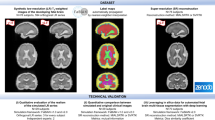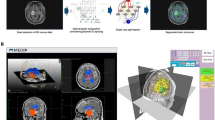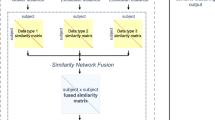Abstract
Background
Medical-imaging-based three-dimensional (3D) printed models enable improvement in skills training, surgical planning, and decision-making. This pilot study aimed to use multimodality imaging and to add and compare 3D ultrasound as a future standard to develop realistic neonatal brain models including the ventricular system.
Methods
Retrospective computed tomography (CT), magnetic resonance imaging (MRI), and 3D ultrasound-based brain imaging protocols of five neonatal patients were analyzed and subsequently segmented with the aim of developing a multimodality imaging-based 3D printed model. The ventricular anatomy was analyzed to compare the MRI and 3D ultrasound modalities.
Results
A realistic anatomical model of the neonatal brain, including the ventricular system, was created using MRI and 3D ultrasound data from one patient. T2-weighted isovoxel 3D MRI sequences were found to have better resolution and accuracy than 2D sequences. The surface area, anatomy, and volume of the lateral ventricles derived from both MRI and 3D ultrasound were comparable.
Conclusions
We created an ultrasound- and MRI-based 3D printed patient-specific neonatal brain simulation model that can be used for perioperative management. To introduce 3D ultrasound as a standard for 3D models, additional dimensional correlations between MRI and ultrasound need to be examined.
Impact
-
We studied the feasibility of implementing 3D ultrasound as a standard for 3D printed models of the neonatal brain.
-
Different imaging modalities were compared and both 3D isotropic MRI and 3D ultrasound imaging are feasible for printing neonatal brain models with good dimensional accuracy and anatomical replication.
-
Further dimensional correlations need to be defined to implement it as a standard to produce 3D printed models.
Similar content being viewed by others
Log in or create a free account to read this content
Gain free access to this article, as well as selected content from this journal and more on nature.com
or
References
Zielonka-Lamparska, E. & Wieczorek, A. P. Usefulness of 3D sonography of the central nervous system in neonates and infants in the assessment of intracranial bleeding and its consequences when examined through the anterior fontanelle. J. Ultrason. 13, 408–417 (2013).
Szpecht, D., Frydryszak, D., Miszczyk, N., Szymankiewicz, M. & Gadzinowski, J. The incidence of severe intraventricular hemorrhage based on retrospective analysis of 35939 full-term newborns-report of two cases and review of literature. Childs Nerv. Syst. 32, 2447–2451 (2016).
Miranda, P. Intraventricular hemorrhage and posthemorrhagic hydrocephalus in the preterm infant. Minerva Pediatr. 62, 79–89 (2010).
Pugliese, L. et al. The clinical use of 3D printing in surgery. Updates Surg. 70, 381–388 (2018).
Papazarkadas, X. et al. The role of 3D printing in colorectal surgery: current evidence and future perspectives. Vivo 33, 297–302 (2019).
Aggarwal, R. & Darzi, A. Technical-skills training in the 21st century. N. Engl. J. Med. 355, 2695–2696 (2006).
Cheng, A., Donoghue, A., Gilfoyle, E. & Eppich, W. Simulation-based crisis resource management training for pediatric critical care medicine: a review for instructors. Pediatr. Crit. Care Med. 13, 197–203 (2012).
Wagner, M. et al. Status quo in pediatric and neonatal simulation in four central European regions: the DACHS survey. Simul. Healthc. 13, 247–252 (2018).
Patel, E. A., Aydın, A., Desai, A., Dasgupta, P. & Ahmed, K. Current status of simulation-based training in pediatric surgery: a systematic review. J. Pediatr. Surg. 54, 1884–1893 (2019).
Everett, T. C., MacKinnon, R., de Beer, D., Taylor, M. & Bould, M. D. Ten years of simulation-based training in pediatric anesthesia: the inception, evolution, and dissemination of the Managing Emergencies in Pediatric Anesthesia (MEPA) course. Paediatr. Anaesth. 27, 984–990 (2017).
Ross, J., Rebella, G., Westergaard, M., Damewood, S. & Hess, J. Simulation training to maintain neonatal resuscitation and pediatric sedation skills for emergency medicine faculty. WMJ 115, 180–184 (2016).
Lee Chang, A. et al. Comparison between simulation-based training and lecture-based education in teaching situation awareness. A Randomized Controlled Study. Ann. Am. Thorac. Soc. 14, 529–535 (2017).
Waran, V. et al. Neurosurgical endoscopic training via a realistic 3-dimensional model with pathology. Simul. Health 10, 43–48 (2015).
Cheng, D. et al. Developing a 3D composite training model for cranial remodeling. J. Neurosurg. Pediatr 1–10 (2019).
Kiraly, L. Three-dimensional modelling and three-dimensional printing in pediatric and congenital cardiac surgery. Transl. Pediatr. 7, 129–138 (2018).
Sánchez-Sánchez, Á. et al. Three-dimensional printed model and virtual reconstruction: an extra tool for pediatric solid tumors surgery. Eur. J. Pediatr. Surg. Rep. 6, e70–e76 (2018).
Padia, R. et al. Simulation-guided tracheotomy in a patient with fibrodysplasia ossificans progressiva. Laryngoscope 129, 812–817 (2019).
Prayer, F. et al. Three-dimensional reconstruction of defects in congenital diaphragmatic hernia: a fetal MRI study. Ultrasound Obstet. Gynecol. 53, 816–826 (2019).
Misra, A., Walters, H. L. & Kobayashi, D. Utilisation of a three-dimensional printed model for the management of coronary-pulmonary artery fistula from left main coronary artery. Cardiol. Young 29, 431–434 (2019).
van Lindert, E. J., Liem, K. D., Geerlings, M. & Delye, H. Bedside placement of ventricular access devices under local anaesthesia in neonates with posthaemorrhagic hydrocephalus: preliminary experience. Childs Nerv. Syst. 35, 2307–2312 (2019).
Weinstock, P. et al. Creation of a novel simulator for minimally invasive neurosurgery: fusion of 3D printing and special effects. J. Neurosurg. Pediatr. 20, 1–9 (2017).
Tack, P., Victor, J., Gemmel, P. & Annemans, L. 3D-printing techniques in a medical setting: a systematic literature review. Biomed. Eng. Online 15, 115 (2016).
Bai, J. et al. Efficacy and safety of 3D print-assisted surgery for the treatment of pilon fractures: a meta-analysis of randomized controlled trials. J. Orthop. Surg. Res. 13, 283 (2018).
Acknowledgements
We would like to thank Editage (www.editage.com) for English language editing. This study was funded with support from the Comprehensive Center for Pediatrics Starter Grant. Part of this work has been supported by the Austrian Research Promotion Agency (FFG): “Additive Manufacturing for Medical Research, M3dRES” Project (Nr. 858060).
Author information
Authors and Affiliations
Contributions
M.W., T.W., E.U., and G.O. conceptualized and designed the study, drafted the initial manuscript, and reviewed and revised the manuscript. G.K., G.D., G.O., C.D., H.S., P.S., K.G., M.O., K.R., and A.B. helped with data collection, the analysis process, and reviewed and revised the manuscript. All authors approved the final manuscript as submitted and agree to be accountable for all aspects of the work.
Corresponding author
Ethics declarations
Competing interests
The authors declare no competing interests.
Statement of consent
No patient consent was required for this study. Permission of the local Institutional Review Board at the Medical University of Vienna (1989/2019) was obtained.
Additional information
Publisher’s note Springer Nature remains neutral with regard to jurisdictional claims in published maps and institutional affiliations.
Rights and permissions
About this article
Cite this article
Wagner, M., Werther, T., Unger, E. et al. Development of a 3D printed patient-specific neonatal brain simulation model using multimodality imaging for perioperative management. Pediatr Res 91, 64–69 (2022). https://doi.org/10.1038/s41390-021-01421-w
Received:
Accepted:
Published:
Issue date:
DOI: https://doi.org/10.1038/s41390-021-01421-w
This article is cited by
-
Quality assurance of 3D-printed patient specific anatomical models: a systematic review
3D Printing in Medicine (2024)



